Gaming the System
Quantifying health/productivity to drive prosocial decisions. Part 6 of a series devoted to exploring the design implications of buildings as part of the human phenotype & our selective environment

In the last article in this series covering the design implications of the built environment’s dual evolutionary nature (that started here), I covered aspects of thermal alliesthesia, biophilia, and indoor air quality (IAQ) relative to evolutionary mismatches and the evolutionary dual nature of our built environments. In this article, we’re stepping back from discussions of the building/occupant organism itself to focus on the larger constraints society places on the decisions made during design and governing (refer to the figure below). The equation B = f(P, E) is still relevant here, but now we’re concerned with the behavior of design and construction professionals, building owners, developers, committee members, government officials, etc., in the environmental context of the design / construction process, the development / updating of standards and codes, the governing of cities, and the like.
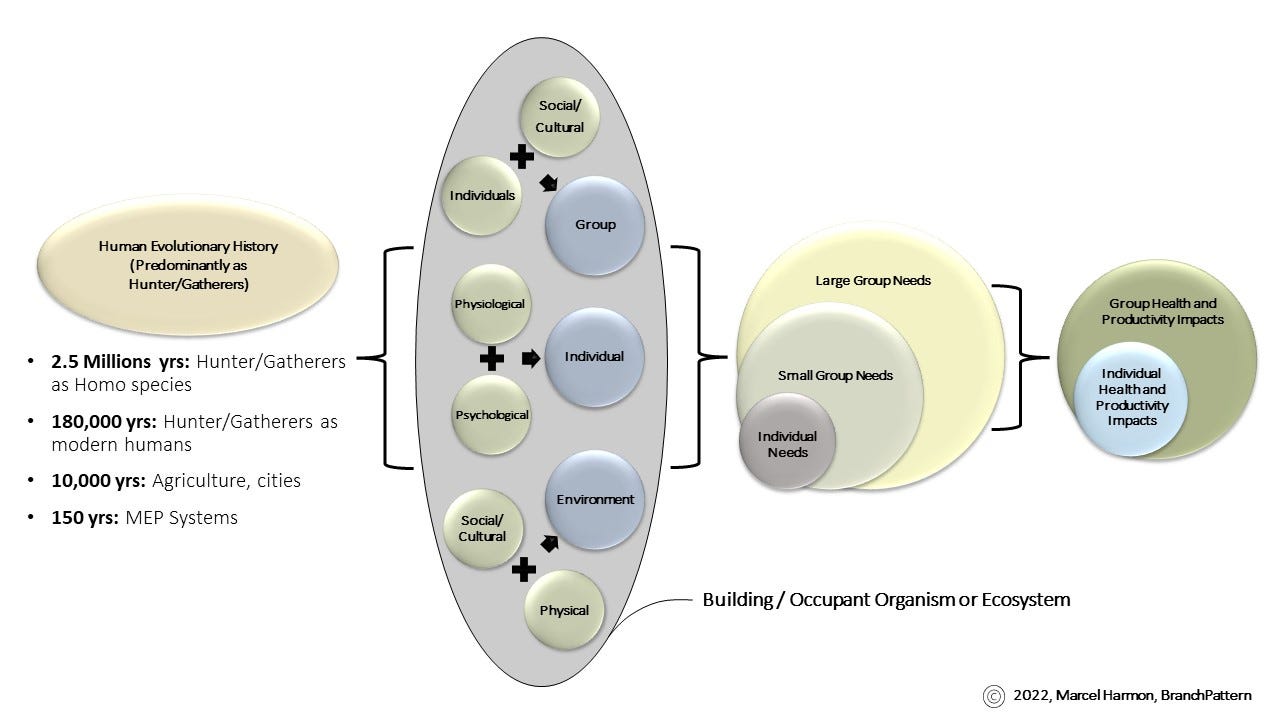
As I covered in the initial article that kicked off this series, the needs and goals of the individuals and groups within this nested hierarchy stretching to the global level vary within each level and between each level, shaped by the various evolutionary forces operating at multiple levels simultaneously - genes, cells, individuals, and at each level of this nested hierarchies of groups. While an oversimplification, within this multilevel selection (MLS) evolutionary framework, environmental and social/cultural conditions are sometimes right for the evolutionary forces to be stronger at the level of the individual. But sometimes these forces are stronger at the group level, resulting in actions and outcomes that more directly benefit the group, sometimes at the expense of member individuals. These same general relationships can be observed comparing lower group levels (e.g., organizations) to higher group levels (e.g., community), all the way up to the global level.
To exemplify this, in the series’ initial article I referenced building phenotypic traits (such as automated shades or skylights) that increase individual occupant fitness levels via facilitating adequate daylight exposure while minimizing unwanted glare and thermal heat gain/loss. But at the same time these phenotypic traits may be perceived as decreasing organizational fitness levels (via increased first cost and/or increased maintenance costs) within a free market economic context (i.e., environment) that focuses on annual profit margins (while also ignoring impacts on people costs).
You might initially assume from the example as described that in an outcome where such traits don’t make it into the final constructed building the dominant level of selection must be the organization. But it’s more complicated than that, as there are many levels at which evolutionary forces are operating simultaneously, multiple environments to consider, and multiple costs/benefits to evolutionary fitness at play. Increasing an organization’s profitability at the expense of employee health/wellness may still provide some fitness benefit to the employee by decreasing the likelihood of being laid off (again, within the environmental context of our free market economy). And increasing the health/wellness of employees can positively impact an organization’s fitness levels by increasing its productivity (when we also consider the impacts on people costs).
The free market economic system, a social construct characterized by minimal government intervention with prices set by competition as well as supply and demand, has its theoretical foundations within the neoclassical economic paradigm. This paradigm, which initially arose during the 19th century, has dominated much of economics for the last 80 years. It supplanted classical economics largely due to it’s integrative framework connecting micro- and macroeconomics through a set of simple assumptions about human behavior tied to nineteenth-century efforts focused on creating a physics of social behavior.
These simple assumptions view individual humans as homo economicus - rational, self-interested, autonomous units acting on perfect information to maximize their utility and, in organizations like businesses, to maximize profits. Its ability to adapt and incorporate elements of alternative economic theories at the time, along with the aura of scientific legitimacy provided by its reliance on mathematical models, sparse language, and seeming rigorous logic, helped solidify its dominance.

But as David Sloan Wilson and Dennis J. Snower have pointed out, the neoclassical economic paradigm, which still shapes so much of our social, economic, and political world, is hampered by its reliance on the myth of homo economicus and it’s inability to effectively account for our vast social and non-human ecological realm, much of which isn’t monetized. As such it is mostly blind to the complexities of our multi-level, evolutionarily shaped landscape. It’s unable to effectively make a nested series of fitness (costs/benefits) comparisons involving a wide variety of physiological, psychological, and social (including economic) factors, across multiple levels over the short and long term.
A few examples include a) ecosystem services (like access to clean air and water) for individuals, communities, and regions, b) unpaid care work, c) the impacts of extreme heat on individual health (and the resulting impacts on our collective workforce), and d) loneliness due to social isolation (potentially influenced by our built environments). Not to mention the inequities associated with all of these. But wait, you might be asking, don’t academic researchers, NGOs, and government agencies attempt to estimate some of these factors? Yes (here’s one example using the DALY metric), but our combined political / economic / social system, at multiple levels, doesn’t consistently take them into account in it’s day-to-day operations. If it did, things would look significantly different.
It doesn’t do this because the underlying values of the neoclassical economic paradigm are focused on never-ending financial growth, tracked annually and manifested nationally as the Gross Domestic Product (GDP) - the value of goods and services exchanged within a nation’s monetized economy in a year (ignoring the vast array of non-monetized services, health factors, states of mind, etc.). But never-ending growth (defined in this manner) is impossible. Nor does the neoclassical economic paradigm effectively account for what it means to be human. All of this, the larger environment we all operate within, increases the likelihood decisions made in design or city commission meetings will benefit annual shareholder profit margins or the status quo of various existing power differentials at the expense of occupant health or equitable community access to clean air and water: B = f(P, E). As Wilson and Snower stated:
There is a widespread agreement, minimally, that the [neoclassical economic] paradigm has not dealt constructively with our current economic, political, social, and environmental crises. Quite possibly, it has been a contributing factor.
For those of us in the AEC Industry trenches, one way to game the system, so to speak, is to monetize some of what typically isn’t, and then include that within the decision-making process (typically through incorporation into some type of life cycle cost analysis). At the individual project or portfolio level, BranchPattern has found that quantifying health and productivity impacts and including them within various financial analyses increases the number of sustainable and health/wellness focused strategies incorporated during planning and design. It also makes them more resistant to removal during value engineering exercises, particularly the more transparent the estimated health and productivity impacts are among all of the relevant key stakeholders (more on why that’s the case in the next article).

Because people costs compose the vast majority of the operational costs for most organizations, quantifying health and productivity impacts can help drive prosocial decisions within the constraints of our neoclassical economic paradigm. In turn, this increases the alignment of our built environment, also part of our extended phenotype, with our short term and long term evolutionarily shaped physiological, psychological, and social needs (many tied to our biological phenotypic traits).
BranchPattern started doing this in 2009 with the development of the initial excel version of our happē™ tool (Health and Productivity, Performance Estimator). Over the years modules have been added and updated based on new research and project requirements. In 2020, a freely accessible online module, the Facility Infection Risk EstimatorTM (FIRE) module, was created in direct response to the pandemic.
In one example from 2018, a corporate client who at the time was leasing 173,000 sq. ft. (16,072 sq. m.) of commercial office space (1,000 seats) and embarking on a tenant improvement project, had a goal of being the healthiest workplace in the region. They came into the project with an interest in implementing an underfloor air distribution system (UFAD), partly driven by a desire to increase their employees’ control over their own thermal comfort. But such a system was only projected to result in a 16% energy savings annually ($121,000) over the baseline case. With a $2.6 million dollar adder over the baseline and looking only at the energy savings, this resulted in a 21 year simple payback, a hard sale in most circumstances, more so considering the 10 year lease.
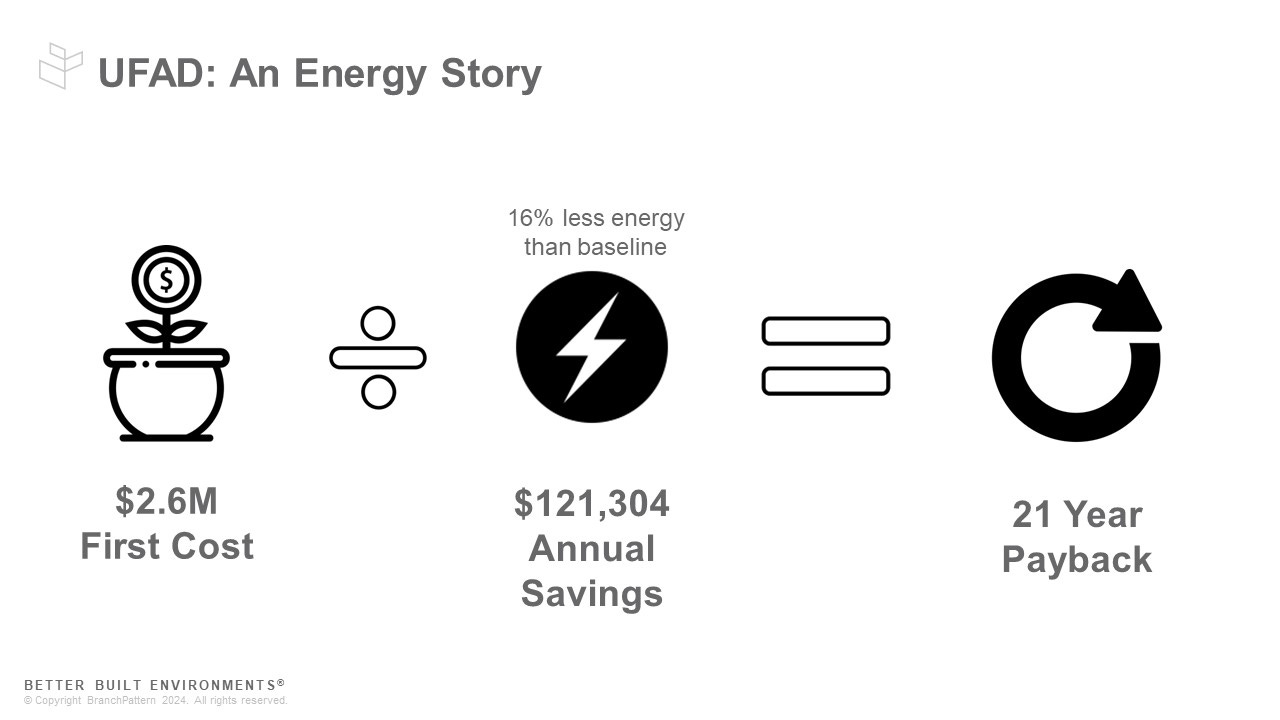
So, in addition to the energy savings we estimated some of the impacts on occupant health and productivity as follows:
Temperature Control: Earlier research has shown that personal control over one's thermal environment can lead to an average productivity increase of 1.2% in an office setting. This improved control (assuming everyone is provided with their own diffuser/control via the UFAD system) also expands the acceptable temperature range, reducing conflicts over thermal comfort and enhancing workplace relationships.
General IAQ Satisfaction: Comparing a UFAD system to an overhead system (the baseline for this case), some earlier research found dissatisfied IAQ responses were cut in half (50% reduction). Other studies have found between a 0.8% and a 1.5% increase in productivity for every 10% reduction in those dissatisfied with the air quality. We conservatively used 0.8%, resulting in a potential 4% increase in productivity comparing the UFAD system to the overhead system (just looking at satisfaction).
Reduced Flu Transmission: One study we found at the time (simulation-based) found a decrease in the potential to contract influenza from 7 out of 30 occupants to 2 out of 30 if a UFAD system with a short throw is employed (compared to an overhead mixing system). Based on these simulated results, the UFAD system had the potential to reduce the risk of contracting the flu during the flu season by 16.7%. I should note that not all subsequent research agrees with these results. The low airspeed and thermal stratification that occurs within the space could end up increasing the concentration of virus containing aerosols within the breathing zone immediately surrounding some occupants, depending on the source location (and therefore potentially increasing the risk of transmission).
Using the client’s average salary, we estimated the productivity dollar amounts associated with improved temperature control and IAQ satisfaction (see figure below). As the influenza study was based on a simulation, and we were then less familiar with viral transmission and how various building strategies could reduce transmission (that quickly changed in March 2020), we chose to only report the potential percentage reduction in flu transmission as opposed to also including an associated dollar amount for the ROI. Being clear that their mileage would vary (and that the only way to perform some type of validation would be to set up a field study similar to other academic studies with a sampling of their employees to measure performance before and after the fact), the simple payback shrunk from 21 years to under 1 year.
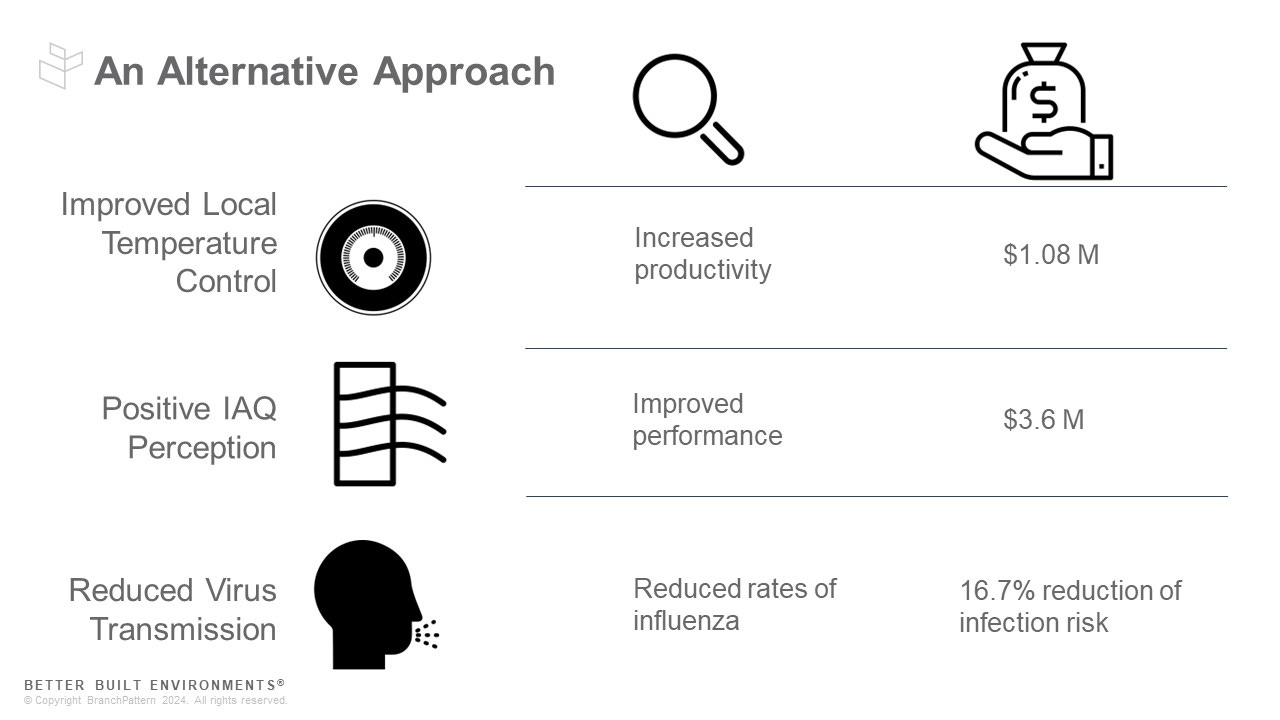
This was enough for the client to justify going with the UFAD system. By added health and productivity factors to the ROI analyses, we brought into play some of the traditionally non-monetized services and factors discussed above. Doing so made these additional factors impacting an organization’s fitness levels visible to the decision-makers who are heavily constrained by the larger social, political, and economic environment shaped by the neoclassical economic paradigm: B = f(P, E).
In another example from 2022, we were contracted to perform retrocommissioning services (with an additional focus on COVID safety measures) for a GSA office building being leased by the one of the divisions of the Federal Highway Administration. As part of the life cycle cost analysis (LCCA) conducted for the various recommended performance enhancement measures (PEMs), we performed a net present value (NPV) analysis. These are often used to estimate whether or not a project’s potential future financial gains via operational savings, health benefits, etc., outweigh alternative present-day investments. A positive NPV value indicates a profitable investment (given the input parameters), i.e., the return exceeds the discount rate (6% was used for this analysis). A negative NPV value indicates financial loss (given the input parameters) as a result of the expenses being higher than, or occurring earlier than, the returns.
The two figures below show the results of the NPV analysis for each of the four PEM packages (PEMs were grouped into these four categories). The results are given for six different investment periods, from five years to 30 years. The first figure only takes into account first cost and projected annual building operations savings/costs.
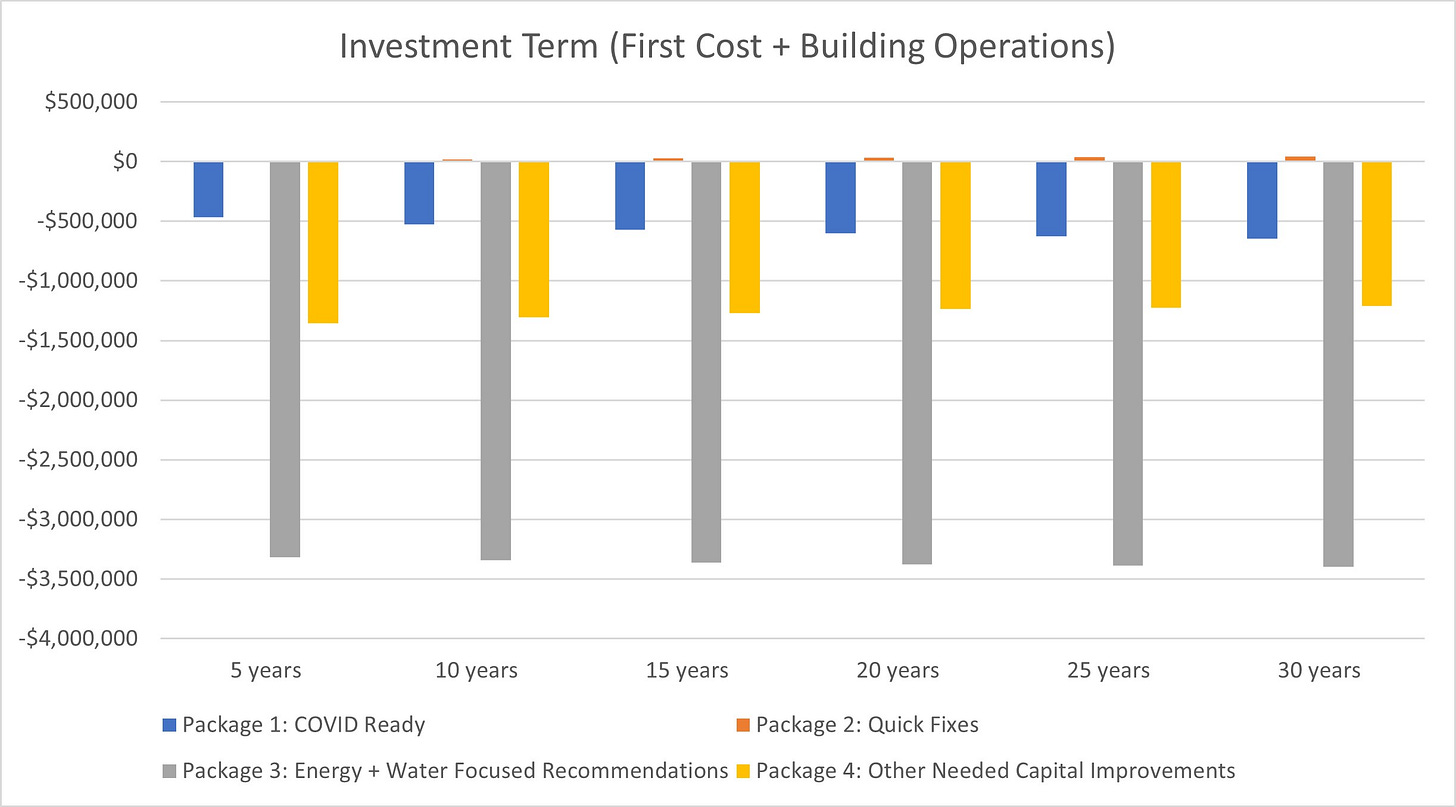
The second figure takes into account first cost, projected annual building operations/costs, and projected annual health/productivity impacts.
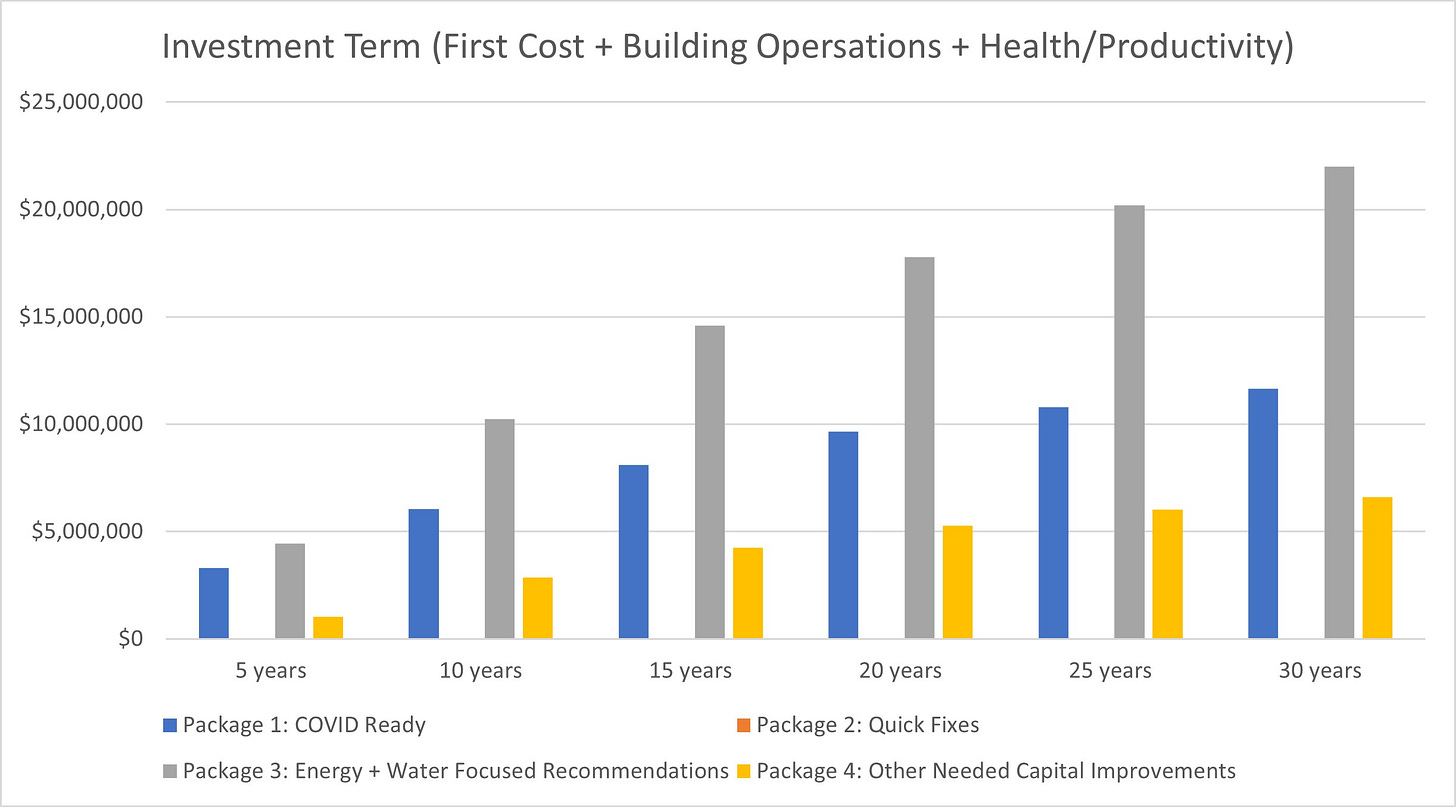
For all of the packages except the quick fixes, including health and productivity impacts was needed to financially justify making the improvements (within the environmental contexts of our free market economy). This was also the case for most of the individual PEMs in each of the relevant three packages as well. Based on the NPV analysis including health and productivity impacts, each of the individual PEMs within each package were also ranked and grouped into separate tiers.
This division of the Federal Highway Administration was going to use the retrocommissioning report to help weigh implementation of recommended improvements (beyond the key COVID safety and quick fix PEMs) vs not renewing their lease and finding another location. While incorporating health and productivity impacts made a difference in their decision-making process, the fact that they could move to another location (that may not require as much work) also weighed against implementing many of the PEMs (and incurring the costs but not the benefits, at least for very long).
This speaks to a key limitation of incorporating health and productivity impacts. For it to be effective, the decision makers need to see a fairly direct link between the financial benefits of positively impacting health and productivity and their own interests (and/or the interests of those they’re representing). In many cases, within the context of our free market economy, the link is too indirect and/or hidden to capitalize on. B = f(P, E).
Another example would be the benefits of reducing a specific site’s heat island effect, ranging from decreased local thermal loads on a building to reduced physiological heat stress. They really start to have significant impacts, financially and otherwise, when combined with other heat island reduction efforts at the community level and higher. The extent of those larger level benefits can’t be factored into an individual project’s LCCA. And even when there is a direct link it may be outweighed by other financial impacts. Then what?
Stay tuned for the next article where I’ll look at how we might drive prosocial behavior more effectively within these larger social, political, and economic constraints that commonly limit the decisions occurring at the project level.



This is remarkable work. I hope a book is forthcoming.